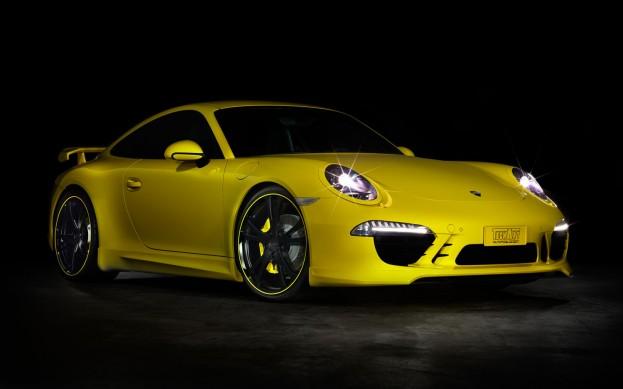 More than any other high-end sports car, aftermarket companies have also loved to customize the Porsche 911. Something about Germany’s iconic sports car attracts companies like Ruf and Gemballa to use the 911 as a blank canvas, even though that canvas is already one of the most exclusive and accomplished sports cars on the market.
More than any other high-end sports car, aftermarket companies have also loved to customize the Porsche 911. Something about Germany’s iconic sports car attracts companies like Ruf and Gemballa to use the 911 as a blank canvas, even though that canvas is already one of the most exclusive and accomplished sports cars on the market.
With the new 991-series 911 out, the tuning companies are at it again. The latest to offer a modified 911 is TechArt, with their bright yellow machine. The company will unveil their new range of 991-911 parts at the Geneva Motor Show. TechArt has been tuning Porsches in 1987; it modifies them so extensively that it is recognized as an independent car manufacturer by the German government.
The changes start on the outside, with a new body kit that includes: a new front fascia, side skirts, a body-color rear diffuser, and quad exhaust tips. TechArt added custom wheels (available in 20 or 21-inch sizes) and a larger rear spoiler that looks like the one from the previous generation (997) 911 GT3.
The interior is colored in the same seizure-inducing shade of yellow. The seat belts and pieces of the leather-and-alcantara interior match the body. The stitching is also yellow, as are the door handles, shifter, gauge surrounds, and HVAC vent sliders. Finally, the 911 gets a TechArt steering wheel with paddle shifters for the double-clutch PDK transmission, a pretty sophisticated touch for an aftermarket parts company.
Since the new 911 hit showrooms only recently, TechArt does not have any serious performance upgrades ready. The words “all show and no go” come to mind. The Geneva Show car will have a new exhaust system with valves that open to make the car sound better at full throttle while still meeting E.U. sound regulations the rest of the time.
TechArt says it will offer its custom 911s in a variety of colors, including a bright red exterior and white interior combination that will probably make the 911 look like Santa’s Florida rental car. The company will also produce different body kits than the one pictured. As with any other high-end carmaker, it’s all about giving the customer the most options.
Tuning started out as the modern form of hot rodding, with car enthusiasts souping up Honda Civics and Nissan 240SXs instead of ’32 Fords and ’57 Chevys. Some might question the wisdom of slapping a body kit on an expensive, high-performance sports car like it’s a ten-year-old Chevy Cavalier. However, everyone wants to stand out, regardless of what they are driving.
In the past, tuners like TechArt were able to massively enhance the performance of the 911; the cars had the substance to back up their showy looks. TechArt promised a series of performance parts for the new 991-series, but until those upgrades arrive the car will be all about showing off.



